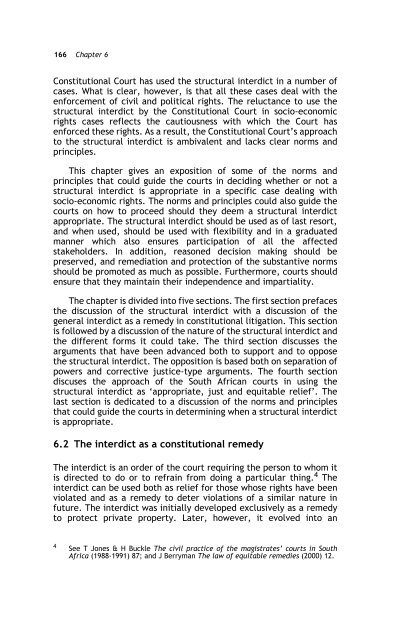LITIGATING SOCIO-ECONOMIC RIGHTS IN SOUTH AFRICA - PULP
LITIGATING SOCIO-ECONOMIC RIGHTS IN SOUTH AFRICA - PULP
LITIGATING SOCIO-ECONOMIC RIGHTS IN SOUTH AFRICA - PULP
You also want an ePaper? Increase the reach of your titles
YUMPU automatically turns print PDFs into web optimized ePapers that Google loves.
166 Chapter 6<br />
Constitutional Court has used the structural interdict in a number of<br />
cases. What is clear, however, is that all these cases deal with the<br />
enforcement of civil and political rights. The reluctance to use the<br />
structural interdict by the Constitutional Court in socio-economic<br />
rights cases reflects the cautiousness with which the Court has<br />
enforced these rights. As a result, the Constitutional Court’s approach<br />
to the structural interdict is ambivalent and lacks clear norms and<br />
principles.<br />
This chapter gives an exposition of some of the norms and<br />
principles that could guide the courts in deciding whether or not a<br />
structural interdict is appropriate in a specific case dealing with<br />
socio-economic rights. The norms and principles could also guide the<br />
courts on how to proceed should they deem a structural interdict<br />
appropriate. The structural interdict should be used as of last resort,<br />
and when used, should be used with flexibility and in a graduated<br />
manner which also ensures participation of all the affected<br />
stakeholders. In addition, reasoned decision making should be<br />
preserved, and remediation and protection of the substantive norms<br />
should be promoted as much as possible. Furthermore, courts should<br />
ensure that they maintain their independence and impartiality.<br />
The chapter is divided into five sections. The first section prefaces<br />
the discussion of the structural interdict with a discussion of the<br />
general interdict as a remedy in constitutional litigation. This section<br />
is followed by a discussion of the nature of the structural interdict and<br />
the different forms it could take. The third section discusses the<br />
arguments that have been advanced both to support and to oppose<br />
the structural interdict. The opposition is based both on separation of<br />
powers and corrective justice-type arguments. The fourth section<br />
discuses the approach of the South African courts in using the<br />
structural interdict as ‘appropriate, just and equitable relief’. The<br />
last section is dedicated to a discussion of the norms and principles<br />
that could guide the courts in determining when a structural interdict<br />
is appropriate.<br />
6.2 The interdict as a constitutional remedy<br />
The interdict is an order of the court requiring the person to whom it<br />
is directed to do or to refrain from doing a particular thing. 4 The<br />
interdict can be used both as relief for those whose rights have been<br />
violated and as a remedy to deter violations of a similar nature in<br />
future. The interdict was initially developed exclusively as a remedy<br />
to protect private property. Later, however, it evolved into an<br />
4<br />
See T Jones & H Buckle The civil practice of the magistrates’ courts in South<br />
Africa (1988-1991) 87; and J Berryman The law of equitable remedies (2000) 12.
















